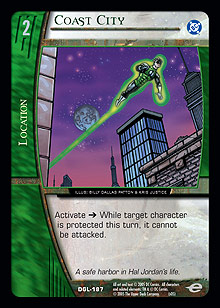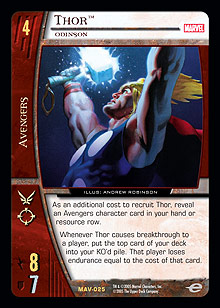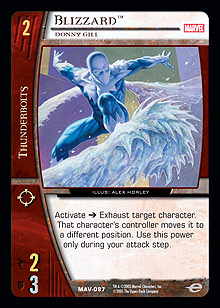
Avengers!!!
Some people like to indulge in primal scream therapy*. Apparently, randomly shouting things out at the top of your voice is a cathartic form of release. Personally, I’m more of a bottler—I allow my emotions to slowly build up. Hence, if you do hear me shouting at the top of my voice, it is normally with good reason. This week, my primal scream formed an infernal harmony with the death rattle coming from Lappy, my laptop of a mere couple of years. Lappy would have gone to meet his makers but for the fact that they have rather frustratingly gone bust.
But what has all this got to do with Vs., you ask? Well, in true “convoluted link time” fashion, the infernal harmonies swung my mind to Ozzy Osbourne, who before he became best known for constantly shouting “Sharon!!!” used to be the lead singer in Black Sabbath. Sabbath, in addition to having a lead guitarist who was (and is) missing the tips of two of his fingers, had a song called Iron Man.
 Iron Man was the card that I wanted to do the preview for more than any other in Vs. I hadn’t seen the cards for The Avengers, but there was something about Tony Stark that very much intrigued me. Maybe it was the fact that, much like the Duracell Bunny, he is constantly engaging in acts of derring-do while really he should be concerning himself with running out of juice. Maybe it was the delicious irony of the fact that if one were to describe a single member of the Marvel universe as “The Man in the Iron Mask,” Stark would probably lose out to Doctor Doom**. Maybe I just had an image of somebody with an Iron for a head.
Iron Man was the card that I wanted to do the preview for more than any other in Vs. I hadn’t seen the cards for The Avengers, but there was something about Tony Stark that very much intrigued me. Maybe it was the fact that, much like the Duracell Bunny, he is constantly engaging in acts of derring-do while really he should be concerning himself with running out of juice. Maybe it was the delicious irony of the fact that if one were to describe a single member of the Marvel universe as “The Man in the Iron Mask,” Stark would probably lose out to Doctor Doom**. Maybe I just had an image of somebody with an Iron for a head.
None of this matters greatly now, of course. If I continue with puns on superhero names for much longer, then I’ll just be Stark raving. The sneak preview events have come and gone, and I’m sure that many of you are happily clutching your extended art copies of Iron Man, Tony Stark to your chests with glee. My silver lining? I get to talk to you about the entirety of the Avengers set and how it all fits together.
Looking at the set as a whole, there are a number of fun little mechanics. There are some that we can all jump in and use straight away, but others seem that they will take some serious time and effort to fully suss out. (How exactly am I going to win with no cards in hand? Time will tell me, and then I’ll tell you.)
With the Marvel sets, there tends to be slightly less in the way of flight and range. Much of this will be purely a flavor concern—if a character does not fly or have laser heat vision or similar, then neither will its card. While having lots of little symbols down the side of the character cards is generally a good thing, there are a lot of positive aspects to having a set or two that has been grounded.
 I’m sure that anyone who has dallied with Golden Age Constructed recently is familiar with playing with Sentinels. With big, scary robots more than able to attack whatever they please and others that keep the team reinforced, there has been less of an impetus for players to really delve into the complexities of the formation step. The Green Lantern set, replete with flight and range, also left players with fewer decisions to make, although the addition of Coast City and Tomar Tu did suggest that there might be a light (lantern?) at the end of the tunnel.
I’m sure that anyone who has dallied with Golden Age Constructed recently is familiar with playing with Sentinels. With big, scary robots more than able to attack whatever they please and others that keep the team reinforced, there has been less of an impetus for players to really delve into the complexities of the formation step. The Green Lantern set, replete with flight and range, also left players with fewer decisions to make, although the addition of Coast City and Tomar Tu did suggest that there might be a light (lantern?) at the end of the tunnel.
There is something magical to me about the formation step. In my experience, the two areas where players seem most able to screw up their turns are formation and the appropriate use of search effects. Anything that makes the formation step that little bit less clear cut can only be a good thing for the better prepared player. If positioning characters becomes more complicated, then the edge that a good player has on an opponent widens that little bit more.
The Avengers—with the combination of fewer characters with flight and/or range, abilities that trigger on breakthrough, and the leader keyword—has just thrown formation right back onto center stage. And now that it’s there, I intend to expose all of its secrets before you, my audience, so that you can be the ones exploiting the edge***.
Essentially, with formations there is only one real concern—to engineer a situation where you can have the best attack step ever. The best attack step ever is one where your characters remain as safe from harm as they could reasonably expect, and where your opponent’s key characters become stunned with minimal losses to your own side. Unless you are planning on winning the game on a given turn, this doesn’t tend to mean all-out attack, but rather surgical strikes that will knock out the key characters on the opposing side of the field.
Unfortunately, this is sometimes easier said than done. As fields start to fill up, the potential for making mistakes increases exponentially with all the extra options. The player with the initiative doesn’t know what his or her opponent will recruit and must make educated guesses accordingly. The defender, on the other hand, has to run through all of the opponent’s reasonable attacks to best work out where each character should stand to be safe.
This is a lot of information to process, and if one went through each option for every turn, then it is entirely possible that opponents would die of old age before they did of endurance loss. As this is a highly dishonorable way to win the game, it’s important to look for shortcuts.
For the player with the initiative, the first issue is to work out which of his or her characters absolutely need to stick around to stay competitive in the game, and how likely they are to do so if they are positioned front and center for the attack. When you have the initiative, it is less likely that an important character will become stunned if you don’t want it to. Rushing in headlong with Garth ◊ Tempest on turn five against an opponent who is likely to be able to stun or KO him at some point on the turn may well be an unnecessary risk.
 Next up, the attacker needs to consider the opponent’s board. Without KO effects, stunning more than one character is normally a priority to ensure that your opponent’s board cannot grow to colossal proportions. If you are running characters such as Lex Luthor, Power Armor or Thor, Odinson, though, or simply looking to push through the final points of damage, then engineering the best way to do breakthrough might be the most important strategic issue. Obviously things are slightly complicated here, since the player with the initiative lacks perfect knowledge of what characters will be on the board. This is where knowledge of the metagame becomes key. Realistically, for any established deck in the metagame, it is relatively straightforward to work out what the ideal recruits are for any given turn if one is playing on curve. If the deck is off-curve, then there will still be key characters that will stand out with little targets on their heads.
Next up, the attacker needs to consider the opponent’s board. Without KO effects, stunning more than one character is normally a priority to ensure that your opponent’s board cannot grow to colossal proportions. If you are running characters such as Lex Luthor, Power Armor or Thor, Odinson, though, or simply looking to push through the final points of damage, then engineering the best way to do breakthrough might be the most important strategic issue. Obviously things are slightly complicated here, since the player with the initiative lacks perfect knowledge of what characters will be on the board. This is where knowledge of the metagame becomes key. Realistically, for any established deck in the metagame, it is relatively straightforward to work out what the ideal recruits are for any given turn if one is playing on curve. If the deck is off-curve, then there will still be key characters that will stand out with little targets on their heads.
Assuming counterattacks aren’t too much of an issue, then a player with the initiative can probably get away with just ensuring that any characters that would like to attack are able to—characters with range can be the back seat bullies, while those without are up-front and personal. Unless there is a clear threat of something to make a monkey of you (Koriand’r ◊ Starfire and Sub-Mariner, Ally of Doom, I’m looking at you) then this will often be the correct setup. Just be sure not to ignore defense entirely without good reason. If it makes no difference in terms of leader effects or similar, try to either protect important ranged characters with big bruisers who can act as a brick wall, or diversify the power of your columns such that counterattackers have trouble getting at everyone they want to. If your wall looks too easy to climb, then you are in effect letting your opponent get a bonus decent stun on the way to attacking the character he or she was after in the first place. Bonuses are not for your opponents. Even at Christmas.
If both players have a similar idea of how to go about forming up (in terms of allowing characters to attack and protecting important characters), then it is reasonable to assume that for the player with the initiative, the real targets will probably be sitting on the back row being protected. Defenders will always be trying to limit the amounts of breakthrough they receive, and this normally encourages some sort of a box formation. The box formation (be it a square or some sort of rectangle) tends to be the strongest in terms of reinforcement and protection. For attackers, the order of attacks will only likely be important if they are looking to cause breakthrough.
Flight is the best weapon of the box-breaker. Stunning a protected character is great, because all of a sudden, the protector becomes a big target for masses of breakthrough. Again, the idea of diversifying the power of any individual column becomes important in limiting the devastation of good attacks. If a flying character is going to be coming over to set up a big breakthrough attack, there is no point in letting it stun a great character while doing so. When planning out defense, assume that flyers will be some of the first attackers, preparing the way for the really big hitters.
The things I’ve gone through so far have been the standard factors I bear in mind given generic characters from the established sets. There have been a few things that have shaken this up a little with the last couple of releases, though. First, there was Play Time. I remember seeing this at the Man of Steel pre-release and thinking it was complete garbage. Surely if your opponent is moving the character, then there is virtually nothing to gain from this little blue? Well, I was way off base on that one. By the time that PC SoCal came around, I would always want a single Play Time in my draft decks. When opponents only have a column of two characters left, forcing a move will at worst mean that both of the characters end up in the back row, allowing you to attack whichever is best, and on occasion will allow you to cause massive amounts of extra breakthrough.
 Play Time is back (and now it has legs) in the form of playful, playful . This little guy is simply amazing at dismantling formations, exhausting potentially scary characters, breaking up leadership, and allowing for all the benefits of extra targets to attack and extra breakthrough. He is also the perfect answer to the biggest defensive trick from the Green Lantern set. Coast City is simply incredible at what it does, which is making the best character on a team really tough to attack. I’m sure that plenty of people will be staring down Sinestro, Green Lantern of Korugar protected by Coast City in various formats for some time to come. Trust me, it is not pleasant. Anything that forces a situation where attack order, in addition to formation, becomes more important makes all of those calculations that much harder for your opponent. I don’t like hard decisions unless I am forcing my opponent to make them.
Play Time is back (and now it has legs) in the form of playful, playful . This little guy is simply amazing at dismantling formations, exhausting potentially scary characters, breaking up leadership, and allowing for all the benefits of extra targets to attack and extra breakthrough. He is also the perfect answer to the biggest defensive trick from the Green Lantern set. Coast City is simply incredible at what it does, which is making the best character on a team really tough to attack. I’m sure that plenty of people will be staring down Sinestro, Green Lantern of Korugar protected by Coast City in various formats for some time to come. Trust me, it is not pleasant. Anything that forces a situation where attack order, in addition to formation, becomes more important makes all of those calculations that much harder for your opponent. I don’t like hard decisions unless I am forcing my opponent to make them.
This is exactly the reason why leader abilities, such as the one of Iron Man, Tony Stark, are so important. The bonuses are clearly nice on offense, but on defense, he directly asks a question of your opponent. If the answer is “Combat annoyances that force me to attack in an order I don’t want to,” then I will happily take “What is Iron Man, Tony Stark?” for ten. If that question can be turned into Double Jeopardy with the addition of a couple more leaders, then so much the better.
Have fun and be lucky,
Tim “Iron Man lives again!” Willoughby
timwilloughby (at) hotmail (dot) com
* Duncan Tang, the Scottish member of Team B.R.A.D.s and Pro Circuit regular, indulges in “random hugs therapy.” Imagine someone with alarmingly high energy levels spreading them around the room by virtue of hugging anybody and everybody who will let him. A lot more constructive in my opinion.
** Take that, Alanis Morissette!
*** Note to readers: anyone caught exploiting U2’s The Edge will not be supported by myself or Metagame, and any injury caused in an Irish bar fight will be entirely the fault of the over-literally-minded reader concerned.